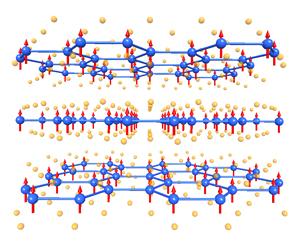
The combined experimental and theoretical study, enabled by growth of large single crystals, revealed the detailed atomic arrangement and magnetic behavior of CrI3. The material is made up of three-atom-thick layers, which are weakly bound to one another. As a result, the material is easily peeled, or cleaved, into very thin sheets. Calculations show the strength of the interlayer bonding is similar to that of graphite, which can be easily cleaved into graphene, a single layer of carbon atoms of great interest for electronics applications. At low temperatures, the magnetic moments of the chromium atoms align with a strong preference to be directed perpendicular to the layers. This ferromagnetism is favored even in single CrI3 layers, enabling magnetism to participate in the electronic functionality of very thin materials.
M. A. McGuire, H. Dixit, V. R. Cooper, and B. C. Sales, “Coupling of crystal structure and magnetism in the layered, ferromagnetic insulator CrI3,” Chemistry of Materials (2015). DOI: 10.1021/cm504242t.
For more information

